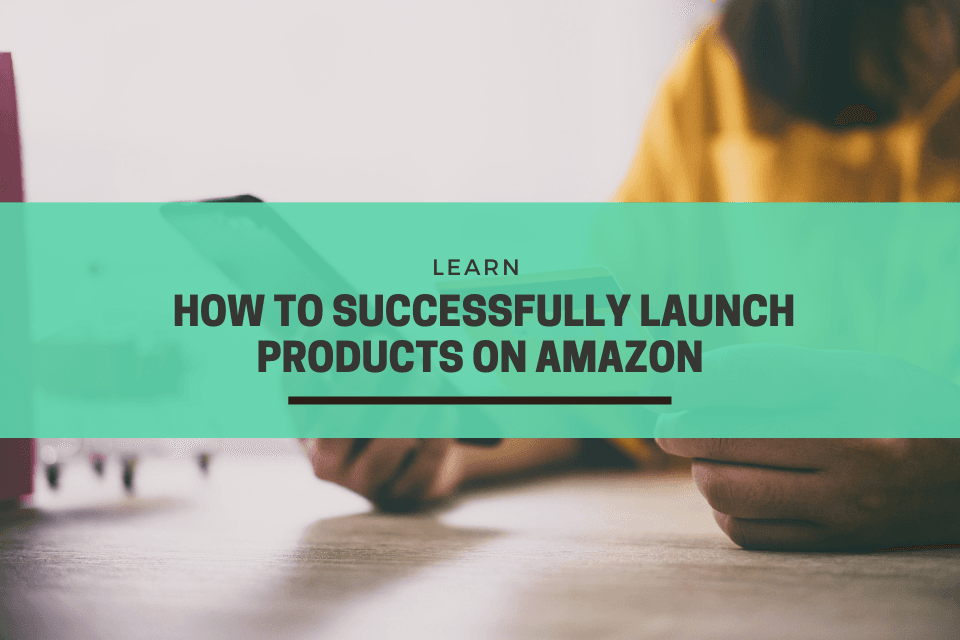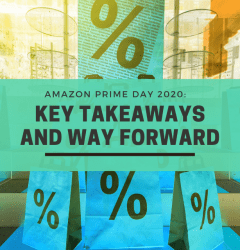This website uses cookies so that we can provide you with the best user experience possible. Cookie information is stored in your browser and performs functions such as recognising you when you return to our website and helping our team to understand which sections of the website you find most interesting and useful.
06 Sep

Learn How to Successfully Launch Products on Amazon
In 2020, Amazon’s total sales reached a whopping $490 billion, out of which third-party sellers sold $300 billion worth of goods. With Amazon becoming the leader in online eCommerce, you may surely be tempted to launch your products and kick-start sales, but at the same time, you may also hesitate to navigate through the complexities of the Amazonian business jungle.
Today, it’s not just about listing the product. Any new seller needs a comprehensive launch strategy for their products to find long term success.
In this blog, we dive into our tried-and-tested checklist to cover all your bases for a successful Amazon product launch plan.
Market & Product Understanding
To realize your growth potential, it is very important to know what kind of market you are jumping into. And to give people a reason for purchasing your products, you should be aware of factors you could leverage in your product category. To get detailed insights into the market, you must do the following:
- Product Research: Once you have picked the product you want to launch, you need to ask yourself questions like ‘does this product bring something new or better to the marketplace?’, ‘what are some of the issues faced in this category?’, ‘how is this product going to address those issues?’, ‘is this product keeping up with the demand or is it just a fad?,’ All these questions will help you gather much more in-depth information about the product and the way it needs to be marketed.
- Competition & Market Sizing: As a seller, you don’t want to step into a category that has no clear differentiation, and has cut-throat competition. Moreover, the market size should be adequate to accommodate new players. Estimating the size of the market, assessing the top players in the category and benchmarking against competitors, therefore, becomes the foundation of your product’s entry to the market.
- Category Selection on Amazon: This might seem trivial, but category selection on Amazon is a crucial decision in launching a product. It can have a huge and sustained impact on your sales, visibility, selling costs, and getting Best Seller tags for your product. Moreover, Amazon has very strict guidelines for Dangerous Goods or products falling under gated-categories. Hence, various factors such as relevance, competition in the sub-category and referral fees percentage, need to be considered.
Annual Sales Targets & Financial Assessment
You need to determine how much revenue you want to generate, especially when launching a new product. These targets will drive the decisions for your inventory planning. A host of business strategies like promotional offers, advertising plans and other marketing efforts will also be largely dependent on achieving your target sales number.
To estimate the sales potential of your new product, you would need to analyze factors like pricing range in your category, product-price mix of the competitors, estimated market share that you could capture, and an overall understanding of your best-case worst-case profit margins based on the product costs you are assuming.
Product Listing
You may have a great product, but it will not attract customers if it does not show up on the top pages of search results on Amazon.
- Keyword Research: The first step to help your product rank is to start off with a detailed keyword analysis, and also look at what keywords your top competitors are using in their listings. A great tool to use here is Amazon Brand Analytics. Want a pro-tip? Analyze the reviews received on similar products and understand the customers’ sentiment, their pain points and the things that attract buyers the most. All of these will help you work on your keyword strategy.
- Listing Optimization: Once you have all the keywords, you now need to include these in various elements of the listing – product title, bulletin points, product description, and backend search terms. Having visually appealing and descriptive images and videos will further help with improving your listing quality and the user experience.
Pre-Launch Activities
Launching a new product without a pre-launch plan is like going to war without weapons! We have observed that whenever a new product is launched, Amazon gives an initial push to the listing to evaluate the user experience (click-through rates, conversion, etc.). Not getting your pre-launch strategy right means that you not only lose out on the precious initial push, but also take longer to figure out what works for your product. Some of the most important aspects of your pre-launch strategy include:
- Inventory Plan: It goes without saying that having your product in-stock for the launch and also the near future is absolutely essential to make sales. We recommend creating a 6-month inventory plan based on your annual sales forecast, and ensuring that this stock is ready-to-go before the actual launch. You must also account for production time, in-transit time, and other elements of your supply chain in this step. Given the current global shipping and logistical challenges being faced, it is very important to have a clear visibility on inventory fulfillment.
- Shipping & Fulfillment: Another crucial aspect is deciding which mode of fulfillment works best as per your business needs and goals. There are primarily two options – FBA and Self-Fulfillment. You need to do a thorough study on your expected sales volume, size of the packaged product, shipping coverage area, extent of control you would want over your inventory, and the various cost elements associated with each of these methods, to finally arrive at a decision on which shipping mode to opt for.
- Package sizing and FBA fees: Make sure that you verify and validate the size of your packaging. If Amazon’s assessment of the packaging is different, a seller may end up paying far more FBA fees than earlier planned, thus throwing your profit estimates to a toss.
- Brand Registry: If you are not already brand registered on Amazon, it is important that you start early. Though this is not a mandatory requirement, Amazon does push sellers to opt for it. You would require a registered trademark to start off, and it could even take up to 6 months to be accepted by Amazon.
- Reviews & Rating Plan: You need reviews and ratings to build sales momentum, and you need more sales to get more of these reviews. This sales-reviews loop makes it quite challenging to successfully launch a new product. Therefore, you must have a plan to gradually build your reviews and ratings. You could initially enrol in Amazon Early Reviewer Program (ERP) or the Amazon Vine Program to gather reviews. You could also plan for automated emails to ask buyers for reviews. But all of this needs to be done in compliance with Amazon’s guidelines.
- Advertising Strategy: In order to get the initial traffic to your newly launched product and generate sales, it is crucial to give your listing an extra push through ads. You need to plan for an ads budget, estimate the revenue you could generate from your advertising efforts and accordingly develop your ad campaigns.
- External Traffic: While Amazon has a large customer base, it is also a highly competitive platform. Therefore, it makes sense to strategize on how you can drive external traffic to your listing through your social media accounts, curated email lists, blog posts, etc. to gain initial traction.
Launch Activities:
After ticking off all the above activities, it is time to actually launch your product. You need to create and publish your product listing, and set up your ad campaigns as planned. You can also get your remaining creative elements up and running, such as A+ content and your Amazon Storefront.
Another crucial aspect that comes with launching any product is building your brand. Opting for affiliate marketing and influencer marketing campaigns at this stage can give that much-needed push to your product and the brand. You could also use promotional tactics such as giveaways or discount codes to drive initial sales.
Post-Launch Activities
This stage covers some of those activities that are required to sustain the listings, right after launch. So, what do you need to do?
- Ensure that your inventory management is on point. Monitor your sales run rate and see how close or far it is from your sales forecast. Your inventory replenishment for the coming months will depend on this.
- Closely monitor your initial reviews. This will give you a feel of the customer sentiment around your product. Also, take necessary action to resolve negative feedback, if any, as and when you receive reviews.
- Promptly respond to FAQs on your listing, to set a positive tone around your brand.
- Plan for ongoing promotions on Amazon like deals, coupons, etc. and keep a tab of the Amazon events calendar to plan your promotions around those.
- Be patient with your ads’ strategy, as it will take a few weeks for a right strategy to fructify. Initial investments will be necessary to see better traction on the platform.
All in all, you must use the aforementioned tips to cover all your bases for a successful product launch on Amazon. If done the right way, you will surely be rewarded with higher sales rolling in. Though this list covers the most crucial elements for a product launch, there is still so much more you could do right from the beginning, to take your product to the next level.
Related Post
Industries Served
United States
India













